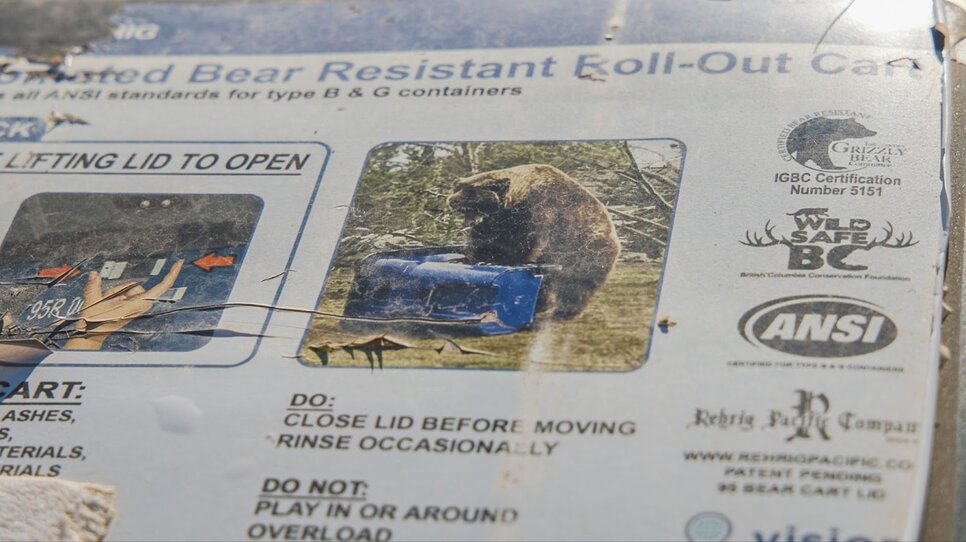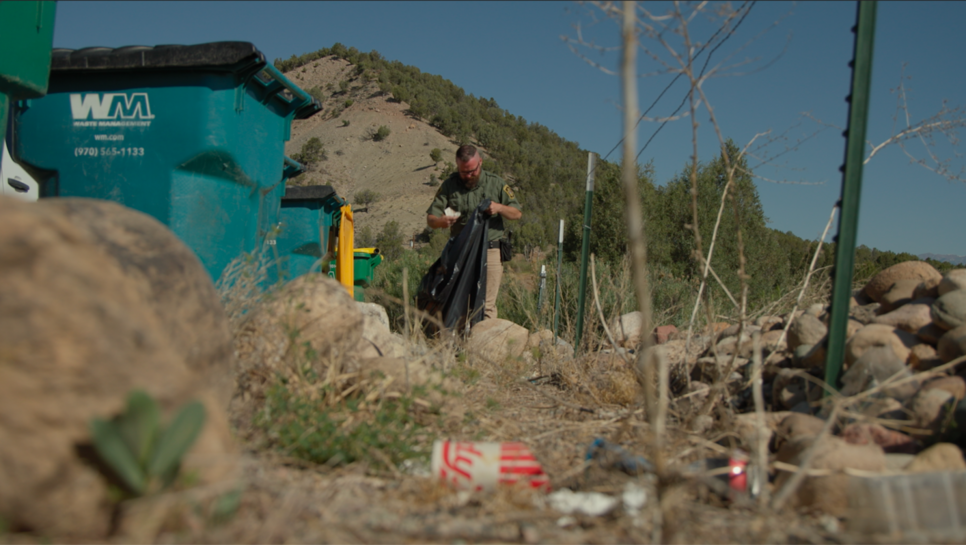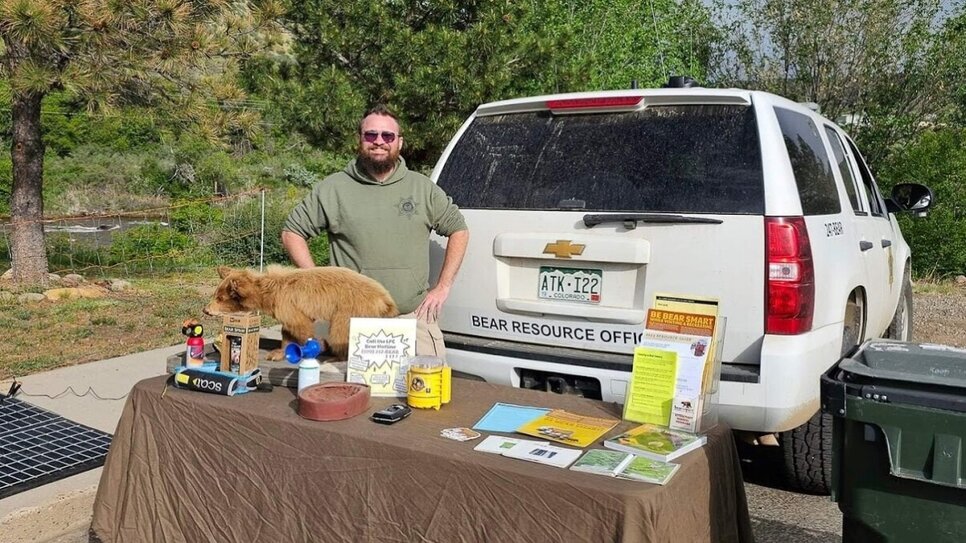Only YOU can prevent bears from eating trash
share

DURANGO, Colo. — At six in the morning, while most of Durango is still asleep, Clarence Dotson gears up for his daily patrol.
Dotson is La Plata County’s first bear resource officer. He mitigates bear-human conflicts and aims to keep wildlife wild with his patrol buddy, Berry the bear.
Seven days a week, he follows waste haulers' routes to check for the signs — knocked-over or damaged cans and torn-open trash bags with a trail of litter — that bears have accessed trash cans.
Dotson must finish his patrol before the waste haulers arrive, or else the evidence of bears will be cleared away.
Dotson stopped at a trash site where a can was knocked over, and litter was scattered across the area. One of the trash cans was missing half of its lid, which Dotson found lying on the ground several feet away.

A trash can with bear-proof certification.
Photo: Ziyi Xu, Rocky Mountain PBS
Dotson picked up the missing half of the lid, pointed to the scratches on it, and said, “Bears will use the plastic lids like a trampoline. They’ll jump on the lid, collapse it inward, and gain access to a trash can that way.”
Dotson turned around, slammed on the lid of another trash can, and continued, “That’s why with bear-resistant ones, you have these super thick, tough lids that lock,” he said.
The mountainous area of La Plata County is home to around 10,000 black bears. In 2022, there were 126 reports of bear sightings in the county and 66 trash-related reports. That same year, the county piloted the bear resource officer position. Dotson is the county’s first and only bear officer. La Plata County also established a bear resource hotline.
The mountainous area of La Plata County is home to around 10,000 black bears. In 2022, there were 126 reports of bear sightings in the county and 66 trash-related reports. That same year, the county piloted the bear resource officer position. Dotson is the county’s first and only bear officer. La Plata County also established a bear resource hotline.
The reason to keep bears away from trash is simple.
“A fed bear is a dead bear,” said Dotson. “The amount of plastics and human refuse they can ingest can cause internal blockages and damage to their intestines. And it's a very high mortality rate for a bear that eats trash.”
Dotson believes that humans and bears should co-exist, but at a respectful distance from each other.
“The goal is to raise bears while making communities aware that bears shouldn't be allowed to just roam their property and eat from their trash cans,” he said. “There is a healthy way to coexist with bears without being detrimental to the species and causing issues for them.”
The trash cans Dotson demonstrated are Interagency Grizzly Bear Committee-certified trash cans, which means they withstood 90 minutes of testing by grizzly bears without being opened. The certification is printed on the lid next to a picture of a grizzly bear trying to open the can.
However, this certification does not guarantee that the can is bear-proof.
“Honestly, there’s no such thing as bear-proof,” said Dotson. “Bears are very smart. They are problem solvers. Sometimes it's trial and error to get it figured out to the best of our abilities to prevent bears from getting into them.”

Dotson cleaning up trash as part of his patrol.
Photo: Ziyi Xu, Rocky Mountain PBS
On his patrol, Dotson cleaned up the trash, reported the incident, and left the trash can owner a 72-hour notice to change to a bear-proof trash can or add a lock to it. He would return to re-evaluate the situation and provide further help if needed.
“We didn't want people to see it as a law enforcement office,” Dotson says of his unique role in wildlife services.
“That's why we wanted to call it the Bear Resource Office. We want people to feel comfortable calling, reporting an issue, asking us for help so we can go out and give them these mitigation solutions that help preserve Colorado's wildlife.”
The Bear Resource Office initiated several civic engagement activities to raise bear awareness, such as hosting events to distribute flyers about bear safety. Dotson and Berry also frequently appear on social media for Bear Fact Friday, as well as informing residents he encounters on his patrol about the resources they offer, such as temporary electric fences, “unwelcome mats” and other bear deterrent devices.
When Dotson was young, he was always told that he would either become a doctor or a veterinarian. His journey to becoming Colorado’s first Bear Resource Officer began in 2012 when he joined the U.S. military as a medic. After medical discharge in 2018, Dotson applied at an animal law enforcement agency has been in animal welfare ever since.
In 2022, when the position of Bear Resource Officer opened up, he immediately applied because of the novelty of this pilot program, the first of its kind in Colorado.
“I love the position. I love being able to help animals and people at the same time. I feel like it's an opportunity for me to branch out and create exposure for our wildlife,” Dotson said.
“I feel like this is an opportunity to spread it to other wildlife communities in Colorado, to help them build a structure and put in place these things that we can do to help preserve the bears.”
What to do if you encounter a bear
Bears might seem cute and furry, but they are wild animals and can be dangerous.
In 2023, a sheep herder was attacked and severely injured by a black bear in Durango. He suffered bite wounds on his head but recovered after surgery.
According to Colorado Parks and Wildlife, bear spray is effective at deterring bears.
But if bear spray is not available and you come across a bear, make loud sounds and big gestures to deter the bear. Using the siren sound on your phone is another option. While doing this, slowly walk backward until the bear is out of sight.
"Do not, under any circumstances, turn around and run," said Dotson. Showing your back to a bear could trigger its hunting instinct.
If you spot a bear near your home or car, enter your home or vehicle immediately. Take a picture of the bear from a safe distance, do not engage with it, and call the bear hotline to report the sighting.

Dotson at a bear-awareness event.
Photo courtesy Clarence Dotson
Despite the potential danger to humans they can pose, one of Dotson’s favorite things about bears is that they actually plant trees.
“Their primary food source is seeds and grasses, and the more seeds they eat, the stomach acids don't break down the seeds. It creates a very healthy fertilizer when a bear leaves its droppings in the woods,” explained Dotson.
“Bears are planting trees more than anything in nature, in my opinion. And without trees, you don't have a healthy ecosystem. You don't have the preservation of national forests and everything related to that,” he said.
Dotson’s eyes light up when he talks about bears.
“I love bears. I can barely contain my excitement for how much I enjoy them,” he said. “Everything from pandas to polar bears to grizzly bears. They're special.”